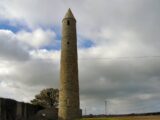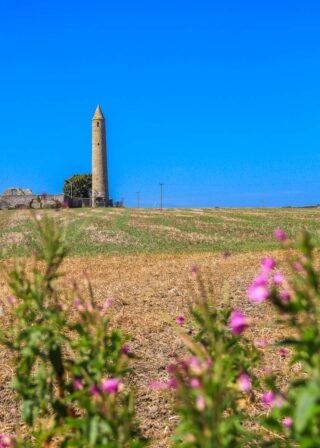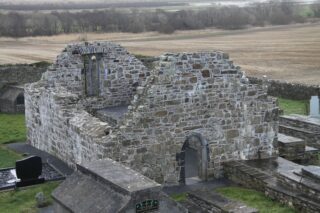Notice
Rattoo Round Tower is a state-owned National Monument in the care of the Office of Public Works
*For External Viewing Only, Internal Access is Not Permitted*
WARNING: It should be noted that these sites are unguided and a level of care and caution should be maintained during all stages of your visit. The Office Of Public Works (OPW) will not be held responsible for any damages, injuries, or losses that occur
Rattoo Round Tower
Rattoo Round Tower is the only surviving complete round tower in Kerry. It stands in an early medieval ecclesiastical complex of Rattoo. The complex includes a graveyard with 29 tombs and 16 named headstones, with the earliest dating to 1770, with a further 45 unnamed headstones. The ecclesiastical complex is thought to date to the 13th century and, with the addition of a round tower, suggests that the site was wealthy. Others suggest that the complex may have been associated with 6th century Bishop Lughach.
What is known is that in 1210 Meiler Fitzhenry was granted much of this area of North Kerry by King John, after the Anglo-Norman invasion. An Augustinian abbey, correctly named The Hospital of St. John the Baptist (Fratres Cruciferi) and Arroasian Abbey of SS. Peter and Paul, was founded by Brother William after 1200. A charter confirms endowment of North Kerry to Meiler Fitzhenry and it goes on to say – built by Friar William in my lands in Kerry, witnessed by David, Bishop of Iarmuan/Ardfert.
There is a brief account in 1318 that the monks were destroyed and burned by the Irish of the locality. When the site was abandoned is unknown. In 1573, the Earl of Desmond was in possession of a lease of the area and this was renewed in 1576, and it is thought the monks remained until the disastrous second Desmond rebellion when all of the Earls properties became the possession of the Crown. It appears that John Zouche, an English commander, was granted the lands of Rattoo. In later centuries the lands were owned by the Gunn family.
The round tower is one of the finest examples in Ireland. Built of hard quartzose sandstone, dressed and evenly coursed inside and out and to a height of c.29m. An off-set of 20cm from its base to the cornice of the cap allows for a gently and even batter. Its basal circumference is 15m. On the interior, it has six floor sitting on a rising ring of projection corbels.
The round headed door at 2.8m above ground, is the entrance door – accessed originally by a ladder, in the south east side of the tower. The door has a flat moulding, two curved spirals on its top arch with spirals on either side of the door, one spiral going clockwise the other anticlockwise. Above the door is a small pointed window, which is the fourth floor, and a further four windows, north, south, east and west, can be seen at the top of the tower.
On the inner frame of the north window a Sheela-na-gig with pellet moulding was discovered during repair work in 1880-81. The Sheela-na-gig, 30cm from head to foot and 14cm at its widest across the knees, is described as ‘flat figure with big head, pronounced forehead and strangely formed, almost rectangular ears, depression indication eyes and mouth, but no nose, a pointed chin, thick neck. Angular shoulders, no breasts. Arms flexed with left hand on thigh, hands not visible in plaster cast, but extension of arm pointing in direction of pudenda, right arm held at right angle. Thighs and calves of figure well rounded, both feet pointing outwards’. In reference to plaster casting, a plaster cast of the Sheela-na-gig is in the National Museum of Ireland. Typically the Sheela-na-gig are architectural grotesques with a heavy concentration in Ireland. The figures were used to ward off evil, demons and death.
Protect our Past - Click here to read about the importance of protecting our country’s unique heritage sites
This national monument is protected in accordance with the National Monuments Acts 1930 to 2014
Gallery
Nearby sites to visit
Listowel Castle
The last bastion of the Fitzmaurices
Approx. 11.1 km from Rattoo Round Tower
Ardfert Cathedral
A trio of medieval churches devoted to St Brendan
Approx. 15.5 km from Rattoo Round Tower
Scattery Island Monastic Site and Visitor Centre
Discover the History, Myth and Legend of Scattery Island
Approx. 20.8 km from Rattoo Round Tower
Desmond Castle Newcastlewest
Where sounds of medieval revelry echo around the walls
Approx. 40.0 km from Rattoo Round Tower
Ross Castle
A lakeside citadel steeped in legend
Approx. 45.3 km from Rattoo Round Tower
Askeaton Castle
A ruined stronghold of the earls of Desmond
Approx. 49.0 km from Rattoo Round Tower




